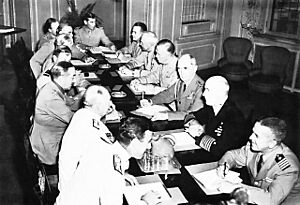Combined Chiefs of Staff facts for kids
The Combined Chiefs of Staff (CCS) was a very important group of military leaders from the United States and Britain during World War II. They made all the big decisions about how the two countries would fight the war. These decisions then had to be approved by British Prime Minister Winston Churchill and U.S. President Franklin D. Roosevelt.
Contents
History
How the CCS Started
The idea for the Combined Chiefs of Staff came from meetings held in Washington, D.C., from December 1941 to January 1942. This was right after the attack on Pearl Harbor. Prime Minister Churchill and his top military advisors used these meetings to plan their overall strategy for the war.
George Marshall, who was the Army Chief of Staff for the U.S., first suggested creating a combined group. He convinced President Roosevelt, and together they convinced Churchill. Some British military leaders, like General Alan Brooke, were not happy about it. Brooke worried that the U.S. would become too powerful if the Allies worked under one command. He also feared that having the CCS in Washington, D.C., would make it hard for Britain to start its own military plans. However, Brooke stayed in London to manage Britain's daily war efforts and wasn't asked for his opinion on this. Other Allied nations, like Free France, also asked to join but were not allowed.
Who Was Involved?
As part of Marshall's plan, President Roosevelt also created the Joint Chiefs of Staff for the American side. The Combined Chiefs of Staff group was based permanently in Washington, D.C. John Dill represented the British side there.
The CCS was made up of the British Chiefs of Staff Committee and the American Joint Chiefs of Staff. The American group was formed partly to show a united front to the British. Their first official meeting was on February 9, 1942. They worked to coordinate military actions between the U.S. Army and Navy.
President Roosevelt approved the CCS's official rules on April 21, 1942. The American members of the CCS included General George C. Marshall, the U.S. Army Chief of Staff. Also, Admiral Harold R. Stark (later replaced by Admiral Ernest J. King) was the Chief of Naval Operations. Lt. Gen. Henry H. Arnold was the Chief of the Army Air Forces. In July 1942, Admiral William D. Leahy, who was the President's personal Chief of Staff, joined the group and led the U.S. Joint Chiefs of Staff.
On the British side, the main Chiefs of Staff usually only attended during big conferences where the heads of state met. Instead, a group called the British Joint Staff Mission stayed in Washington, D.C., all the time to represent Britain. This mission included representatives from the British Prime Minister and the Chiefs of Staff Committee. The Prime Minister's representative was Field Marshal Sir John Dill, and later Sir Henry Maitland Wilson. Dill was a close friend of Marshall and often helped both sides agree.
The CCS also had a special office called the Combined Secretariat and many other smaller committees.
Dividing the War Effort
In the spring of 1942, Britain and the United States decided how to divide up their military responsibilities around the world. On March 24, 1942, the U.S. Joint Chiefs of Staff were given the main responsibility for the war in the Pacific Ocean. The British Chiefs were responsible for the Middle East and Indian Ocean. The European, Mediterranean, and Atlantic areas were a shared responsibility for both groups. China was its own separate area, led by its chief of state, Chiang Kai-shek, but it was still part of the U.S. area of responsibility.
The CCS usually met in Washington, D.C. The full group only met during the big wartime conferences, like the Casablanca Conference in January 1943. These conferences were where the leaders of the governments made final agreements on plans that the CCS had already worked out.
Even though it reported to both the British and American governments, the CCS managed forces from many different countries. These forces were fighting in places like the Pacific, India, and North Africa. Other Allied nations were not official members of the CCS. However, the CCS did talk with "Military Representatives of Associated Powers" about important strategy issues.
After the War
When the war ended, it was unclear what would happen to the CCS. Some American military leaders, like Marshall, wanted to keep it. But most Americans and their government wanted to stop the joint British-American command. They preferred working with many countries, like through the United Nations, or going back to the U.S. being less involved in other countries' affairs. Many Americans also didn't like the idea of the British Empire.
However, the start of the Cold War made people think more about working closely with Britain again. This was partly because of Soviet spying being discovered in the U.S.
So, Britain and America continued to work together militarily after the war, and the CCS structure was even used again during the Berlin Blockade in 1948. At the same time, other major Western European countries wanted to be part of the CCS too. They knew they would need American help if the Soviet Armed Forces attacked Western Europe.
The creation of the North Atlantic Treaty Organization (NATO) changed everything. NATO created a unified command structure that included many countries from both North America and Western Europe. This meant the CCS was no longer needed. In 1949, the British government agreed to end the CCS in exchange for closer cooperation with the United States Department of Defense.
Today
The US Joint Chiefs of Staff and the UK's Chiefs of Staff Committee have met again as a "Combined Chiefs of Staff Committee." This happened around March 2013, which was the first time since their World War II meetings. That meeting was in Washington, D.C. They also met in London in 2014 and in the National Defense University in May 2015.
See also


